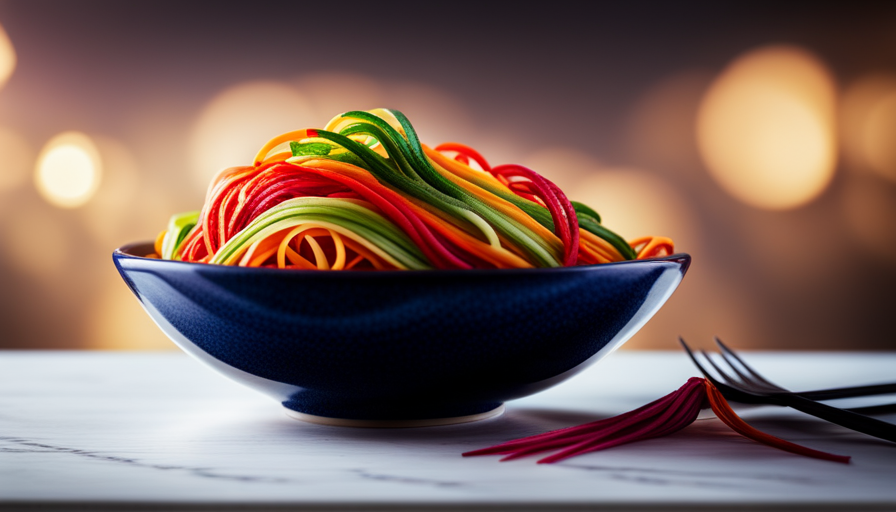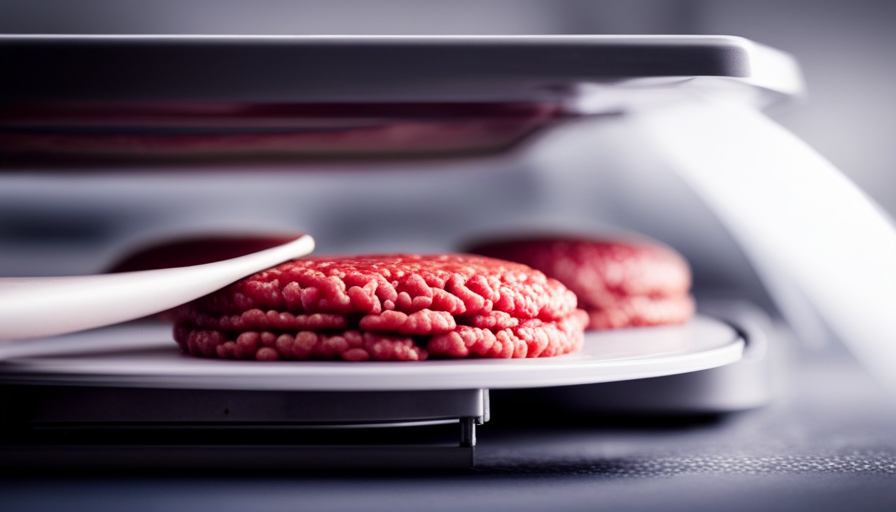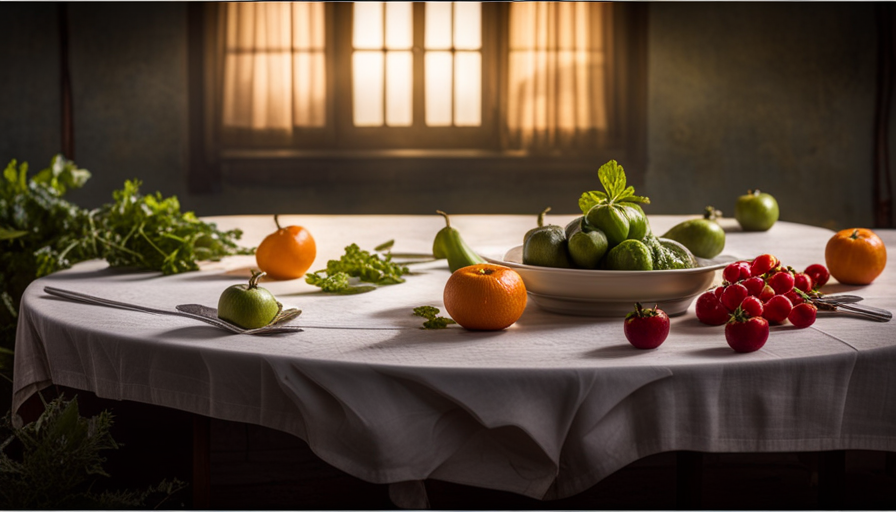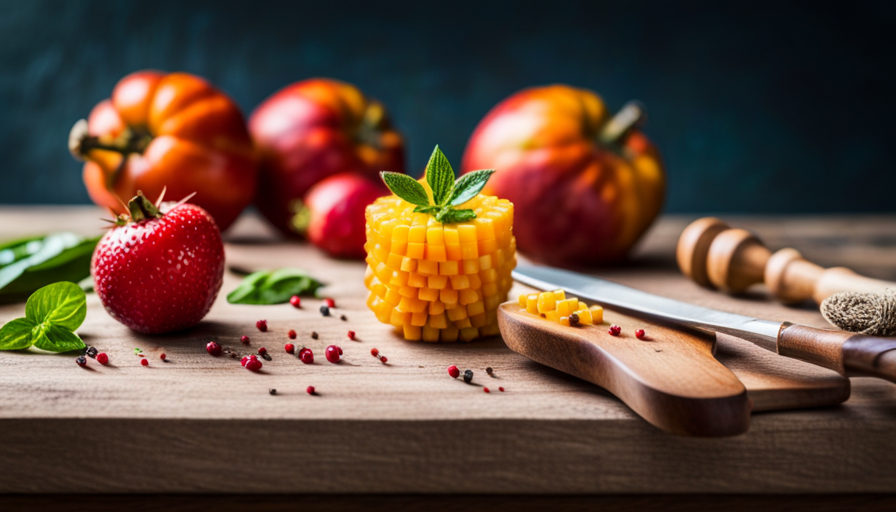Have you ever thought about what raw food noodles are and why they are becoming popular? You may be wondering, ‘Why should I eat noodles that have not been cooked?’ Let me assure you, raw food noodles are not just tasty, but they are also full of nutrients and provide numerous health advantages.
Raw food noodles are made from vegetables, such as zucchini, carrots, or sweet potatoes, that are spiralized or thinly sliced to resemble traditional noodles. They are a fantastic alternative for those looking to reduce their carbohydrate intake or for those following a raw or vegan diet.
In this article, we will explore the different types of raw food noodles, how they are made, and the nutritional benefits they offer. We will also provide tips for buying and storing raw food noodles, as well as share some mouthwatering recipes to get you started.
So, if you’re curious about incorporating raw food noodles into your diet, keep reading!
Key Takeaways
- Raw food noodles are made from vegetables and fruits, providing a healthier alternative to traditional wheat-based noodles.
- They are low in calories, carbohydrates, and gluten-free, making them suitable for weight management and low-carb diets.
- Raw food noodles are packed with nutrients, vitamins, minerals, and antioxidants, offering a nourishing and visually appealing meal option.
- Incorporating raw food noodles into your diet can boost your immune system, improve digestion, and increase your intake of vegetables by 80%.
Definition of Raw Food Noodles
Raw food noodles are a type of uncooked pasta made from vegetables like zucchini or carrots, providing a healthier alternative to traditional wheat-based noodles. These noodles are created by using a spiralizer or a julienne peeler to transform the vegetables into long, thin strands that resemble pasta.
One of the benefits of raw food noodles is that they are packed with nutrients and are low in calories, making them an excellent choice for those looking to eat a nutritious and balanced diet. Additionally, raw food noodles are gluten-free, making them suitable for individuals with gluten sensitivities or those following a gluten-free diet.
There are different variations of raw food noodles, each offering its own unique taste and texture. Zucchini noodles, also known as zoodles, are the most popular type of raw food noodles. They have a mild flavor and a tender, yet slightly crunchy texture. Carrot noodles, on the other hand, have a slightly sweeter taste and a firmer texture. Other vegetables that can be used to make raw food noodles include cucumber, sweet potato, and beetroot.
Now, let’s explore the various types of raw food noodles and discover the endless possibilities they offer for creating delicious and healthy meals.
Types of Raw Food Noodles
When it comes to raw food noodles, there’s a whole world of options to explore.
Vegetable noodles are a popular choice, offering a nutritious and low-carb alternative to traditional pasta.
Fruit noodles add a touch of sweetness to dishes and can be a refreshing addition to salads or desserts.
And let’s not forget about the other raw ingredients that can be used to create unique and flavorful noodles, like seaweed or zucchini.
Get ready to discover a whole new way to enjoy noodles with these exciting options!
Vegetable Noodles
To experience a burst of flavor and a vibrant array of colors, you should try spiralizing vegetables into noodles. Vegetable noodles are not only delicious but also packed with nutritional value. By replacing traditional pasta with vegetable noodles, you can enjoy a low-carb and gluten-free alternative.
From zucchini to sweet potatoes, there’s a wide variety of vegetables that can be transformed into noodles. These vegetable noodles can be cooked in various ways, such as sautéing, boiling, or even enjoying them raw. Cooking methods can help enhance the texture and flavor of the noodles. They can be seasoned with herbs and spices or tossed in a sauce to create a satisfying meal.
Now, let’s move on to the next section about fruit noodles, where you can explore a whole new world of fruity flavors.
Fruit Noodles
Indulge in a delightful symphony of flavors and colors as you spiralize fruits into tantalizing noodles, opening up a captivating world of fruity bliss. Fruit noodles offer a refreshing twist compared to their vegetable counterparts.
Here are four flavor variations of raw food noodles that’ll take your taste buds on an exciting journey:
-
Sweet and tangy: Spiralized apple or pear noodles bring a burst of natural sweetness to your dish, complemented by a hint of tanginess.
-
Tropical paradise: Try spiralizing ripe mango or pineapple for a taste of the tropics. These fruit noodles add a juicy and exotic flavor to your meals.
-
Zesty citrus: Create zingy noodles by spiralizing oranges or lemons. The bright citrusy notes add a refreshing kick to your dish.
-
Berrylicious: Spiralize strawberries or blueberries for a burst of juicy berry goodness. These fruit noodles are perfect for adding a pop of color and natural sweetness.
As we explore other raw ingredients, let’s discover how they can elevate your culinary creations.
Other Raw Ingredients
Immerse yourself in a world of vibrant flavors and textures as you explore the endless possibilities of incorporating fresh and uncooked ingredients into your culinary creations. Raw food noodles are not limited to just fruit; there is a whole array of other ingredients that can be used to create these delicious and healthy noodles. From vegetables like zucchini, carrots, and cucumber, to seaweed and kelp, the options are truly endless. These ingredients can be spiralized, shaved, or thinly sliced to mimic the texture of traditional noodles. By using other ingredients in addition to fruit, you can create a variety of flavors and colors that will make your dishes visually stunning and incredibly tasty. Now, let’s dive into how raw food noodles are made, and discover the art behind this nutritious and delicious trend.
How Raw Food Noodles are Made
When it comes to making raw food noodles, there are several methods that can be used. One popular technique is spiralizing, which involves using a spiralizer to create long, thin strands of vegetables or fruits.
Another option is to use a mandoline or grater to shred the ingredients into noodle-like shapes.
Lastly, a julienne peeler can be used to create thin, strip-like noodles.
Each method offers a unique way to transform raw ingredients into delicious and healthy noodle alternatives.
Spiralizing
Try spiralizing your vegetables to create raw food noodles that are both visually appealing and full of flavor. Spiralizing is a technique that involves using a spiralizer to turn vegetables into noodle-like shapes. It’s a fun and creative way to incorporate more raw foods into your diet.
The benefits of raw food noodles are numerous. Firstly, they’re a great alternative to traditional pasta, as they’re low in calories and carbohydrates. Secondly, they’re packed with nutrients and vitamins that are often lost during cooking. Additionally, raw food noodles are a great option for those with dietary restrictions, as they’re gluten-free and suitable for a variety of diets.
So why not give spiralizing a try and enjoy the many benefits of raw food noodles? In the next section, we’ll explore another technique for creating these delicious noodles using a mandoline or grater.
Using a Mandoline or Grater
Using a mandoline or grater is a simple yet effective way to transform your vegetables into delightful, noodle-like ribbons. When using a mandoline, it’s important to prioritize safety. Make sure to use the hand guard to protect your fingers from the sharp blades.
Begin by setting your mandoline to the desired thickness, usually around 1/8 inch. Hold the vegetable firmly and slide it across the mandoline in a smooth, steady motion. The result will be beautiful, uniform ribbons that resemble noodles.
On the other hand, if you prefer a finer texture, a grater can be a great alternative. Use a box grater with the appropriate blade size and grate the vegetable using downward strokes. This technique creates shorter, thinner strands that are perfect for a variety of dishes.
Now, let’s move on to using a julienne peeler to create even more noodle possibilities.
Using a Julienne Peeler
To create a variety of flavorful dishes, grab a julienne peeler and discover the endless possibilities of transforming your vegetables into delightful, ribbon-like strands. Did you know that using a julienne peeler can save you time in the kitchen, allowing you to enjoy your meals faster?
Not only does a julienne peeler give your vegetables a beautiful presentation, but it also offers numerous benefits. By using a julienne peeler, you can easily create alternative noodle options that are low in carbs and calories. Whether you want to replace traditional pasta with zucchini noodles or enjoy a refreshing carrot salad, a julienne peeler is your secret weapon.
Now, let’s delve into the nutritional benefits of raw food noodles and how they can enhance your well-being.
Nutritional Benefits of Raw Food Noodles
Raw food noodles offer a burst of vibrant flavor and a plethora of essential nutrients, providing a nourishing and visually appealing meal option. Whether you’re a health enthusiast or simply looking to add more variety to your diet, raw food noodles are a fantastic choice.
There are numerous raw food noodle recipes available that can be easily prepared using a julienne peeler or a spiralizer. These recipes often feature a variety of vegetables such as zucchini, carrots, or sweet potatoes, which are transformed into long, thin strands resembling traditional noodles.
One of the main health benefits of raw food noodles is their high nutrient content. Vegetables used to make raw food noodles are packed with vitamins, minerals, and antioxidants that support overall health. They are also low in calories and carbohydrates, making them a great option for those watching their weight or following a low-carb diet. Additionally, raw food noodles are a great source of dietary fiber, which can aid in digestion and promote a feeling of fullness.
Incorporating raw food noodles into your diet can also help increase your intake of vegetables. Many people struggle to consume enough vegetables daily, but by opting for raw food noodles, you can easily meet your daily vegetable quota. This can contribute to improved overall health and well-being.
Transitioning into the subsequent section about the health benefits of raw food noodles, it’s important to understand the impact they can have on your overall health and wellness.
Health Benefits of Raw Food Noodles
Incorporating raw vegetable noodles into your diet can be a game-changer for your health. According to a recent study, they offer a surprising 80% increase in daily vegetable intake. Raw food noodles, made from vegetables like zucchini, carrots, or sweet potatoes, are packed with essential nutrients and have numerous health benefits.
One of the main benefits of raw food noodles is their high nutrient content. They’re rich in vitamins, minerals, and antioxidants, which can help boost your immune system, improve digestion, and promote overall well-being. Additionally, raw food noodles are low in calories and carbohydrates, making them a great option for those looking to lose weight or maintain a healthy diet.
There are several ways to prepare raw food noodles, allowing you to enjoy their benefits in various delicious dishes. You can use them as a base for salads, toss them with your favorite sauces and dressings, or even incorporate them into stir-fries. The possibilities are endless, and experimenting with different recipes can add excitement to your meals.
Incorporating raw food noodles into your diet can provide numerous health benefits. From increasing your vegetable intake to boosting your nutrient intake, these noodles are a versatile and nutritious addition to any meal.
In the next section, we’ll explore creative ways to use raw food noodles that’ll take your culinary experience to the next level.
Creative Ways to Use Raw Food Noodles
If you’re looking to spice up your meals and add some healthy variety, get ready to discover some creative ways to bring a new twist to your vegetable-based dishes. Raw food noodles are incredibly versatile and can be used in a variety of creative ways to make your meals more exciting and nutritious. Here are three ideas to get you started:
-
Raw Pad Thai Salad: Toss your raw food noodles with colorful vegetables like bell peppers, carrots, and bean sprouts. Add a tangy dressing made from lime juice, tamari, and almond butter for a burst of flavor. Top it off with some crushed peanuts for an extra crunch.
-
Raw Zucchini Pasta with Pesto: Spiralize your raw food noodles using a spiralizer or julienne peeler. Mix them with a fresh and vibrant pesto made from basil, pine nuts, garlic, and olive oil. This light and refreshing dish is perfect for a quick and easy lunch.
-
Raw Veggie Sushi Rolls: Use your raw food noodles as a filling for homemade sushi rolls. Lay out a sheet of nori, spread a thin layer of avocado on top, and then add your noodles along with sliced cucumbers, carrots, and bell peppers. Roll it up tightly and slice into bite-sized pieces.
By incorporating these creative uses of raw food noodles into your meal rotation, you can enjoy the health benefits of eating more vegetables while adding excitement to your plate. Now, let’s move on to some tips for buying and storing raw food noodles.
Tips for Buying and Storing Raw Food Noodles
When it comes to buying and storing raw food noodles, there are a few key points to keep in mind. First and foremost, I always prioritize choosing fresh and organic ingredients. This ensures that I’m getting the highest quality noodles, packed with nutrients and free from harmful pesticides.
Additionally, proper storage techniques are crucial to maintaining the noodles’ freshness and texture. I’ll be sharing some tips and tricks to help you make the most of your raw food noodles and maximize their shelf life.
Choosing Fresh and Organic Ingredients
To ensure you’re getting the healthiest meal possible, be sure to opt for fresh, organic ingredients when making your raw food noodles – it’s like giving your body a vibrant symphony of flavors and nutrients! Here are four reasons why choosing fresh produce and organic foods is the way to go:
-
Fresh produce: Using fresh ingredients enhances the taste and texture of your raw food noodles. The crispness of fresh vegetables adds a delightful crunch to every bite.
-
Nutrient-rich: Organic foods are grown without synthetic pesticides or fertilizers, allowing them to retain more nutrients. By using organic ingredients, you’re maximizing the nutritional value of your meal.
-
No harmful chemicals: Conventional produce often contains residues of pesticides and other chemicals. By choosing organic, you’re avoiding these harmful substances and supporting sustainable farming practices.
-
Environmental impact: Organic farming methods promote soil health and biodiversity, reducing the negative impact on the environment.
By selecting fresh, organic ingredients, you’re not only benefiting your health but also supporting sustainable agricultural practices.
Now, let’s explore proper storage techniques for your raw food noodles.
Proper Storage Techniques
After carefully selecting fresh and organic ingredients for my raw food noodles, it’s important to know how to properly store them. Proper storage techniques not only help maintain the quality and flavor of the ingredients, but they also ensure their safety for consumption.
One of the key benefits of proper storage is that it helps prevent the growth of harmful bacteria and other microorganisms that can cause foodborne illnesses. For example, storing vegetables in the refrigerator helps slow down the rate of spoilage and preserves their nutritional value.
Additionally, storing dry ingredients like noodles in airtight containers in a cool and dry pantry prevents them from becoming stale or infested with pests. By following these storage techniques, I can confidently enjoy my raw food noodles knowing that they are fresh, safe, and full of flavor.
Now, let’s move on to the next section about shelf life and expiration dates.
Shelf Life and Expiration Dates
Understanding the shelf life and expiration dates is crucial for ensuring the quality and safety of the ingredients used in my culinary creations. When it comes to raw food noodles, proper storage techniques are essential in maintaining their freshness and flavor.
Raw food noodles typically have a shorter shelf life compared to cooked noodles, so it’s important to consume them within the recommended timeframe. To prolong their shelf life, store raw food noodles in an airtight container in the refrigerator. This will help prevent moisture and bacterial growth, ensuring that the noodles stay fresh for longer. However, it’s important to note that raw food noodles can still spoil if not consumed within a certain period.
Now that we understand the importance of shelf life and storage, let’s dive into some delicious raw food noodle recipes that will tantalize your taste buds.
Delicious Raw Food Noodle Recipes
Get ready to tantalize your taste buds with these mouthwatering raw food noodle recipes! Raw food noodles are a nutritious and delicious alternative to traditional cooked noodles. They are made from vegetables like zucchini, carrots, or sweet potatoes, which are spiralized into noodle-like shapes. These raw food noodles can be enjoyed in a variety of ways, from raw food noodle salads to flavorful raw food noodle dressings.
To give you a taste of what’s possible, here are three delectable raw food noodle recipes:
-
Zucchini Pad Thai: In this refreshing dish, zucchini noodles are tossed with a tangy sauce made from almond butter, lime juice, and tamari. Topped with crunchy bean sprouts, chopped peanuts, and fresh cilantro, it’s a burst of flavors in every bite.
-
Carrot Sesame Noodles: These vibrant orange noodles are coated in a creamy sesame dressing made from tahini, tamari, and a hint of ginger. Garnished with sesame seeds and green onions, they are a visual delight and a treat for your palate.
-
Sweet Potato Curry Noodles: These hearty noodles are dressed in a creamy curry sauce made from coconut milk, curry powder, and garlic. Topped with crispy tofu and chopped cilantro, they are a satisfying and flavorful meal.
Now that you’re drooling over these incredible raw food noodle recipes, let’s move on to answering some frequently asked questions about raw food noodles.
Frequently Asked Questions about Raw Food Noodles
Ready to satisfy your curiosity about these veggie-based noodle alternatives? Raw food noodle alternatives are an exciting and nutritious way to add variety to your meals. Made from vegetables like zucchini, carrots, or kelp, these noodles offer a refreshing twist to traditional pasta dishes. But before you dive in, it’s important to address some frequently asked questions about raw food noodles.
-
Are raw food noodles healthy? Absolutely! They’re packed with vitamins, minerals, and fiber, making them a great choice for those looking to incorporate more vegetables into their diet.
-
How do I prepare raw food noodles? Simply spiralize or julienne the vegetables, and they’re ready to eat. No cooking necessary!
-
Can raw food noodles be eaten hot? While they’re typically enjoyed raw, you can also lightly sauté or steam them if you prefer a warm dish.
-
Are there any potential side effects of raw food noodles? Some people may experience bloating or gas due to the high fiber content. It’s important to listen to your body and adjust your portion sizes accordingly.
-
Can raw food noodles be used in any recipe? Absolutely! Whether you’re craving a refreshing salad, a stir-fry, or a hearty soup, raw food noodles can be a versatile addition to any dish.
Now that you have a better understanding of raw food noodles, let’s explore how you can incorporate them into your diet in the conclusion: incorporating raw food noodles into your diet.
Conclusion: Incorporating Raw Food Noodles into Your Diet
To truly diversify your meals and nourish your body, it’s time to embrace the versatility of these vegetable-based alternatives and start incorporating them into your diet today. Raw food noodles are an incredible addition to any meal plan, offering a range of benefits that’ll leave you feeling satisfied and energized.
One of the main benefits of incorporating raw food noodles into your diet is the abundance of nutrients they provide. These noodles are made from fresh vegetables like zucchini, carrots, or sweet potatoes, which are packed with vitamins, minerals, and antioxidants. By swapping traditional pasta for raw food noodles, you’ll be giving your body a nutrient boost without sacrificing taste.
Another advantage of raw food noodles is their low calorie and carb content. If you’re watching your weight or following a low-carb diet, these noodles are a perfect choice. They’re light, refreshing, and can be enjoyed guilt-free. Additionally, raw food noodles are gluten-free and suitable for those with dietary restrictions or sensitivities.
Incorporating raw food noodles into your meals is easy and fun. You can use a spiralizer to create noodle-like shapes from the vegetables or purchase pre-made options from your local grocery store. From salads to stir-fries, raw food noodles can be used in a variety of dishes, adding a crunchy texture and vibrant color.
So why wait? Start experimenting with raw food noodles today and discover the many benefits they have to offer. Your taste buds and body will thank you!
Frequently Asked Questions
Are raw food noodles gluten-free?
Yes, raw food noodles can be gluten-free! These noodles are made from vegetables like zucchini or carrots, which are spiralized to create a noodle-like shape. They’re a fantastic gluten-free option for those with dietary restrictions. Not only are they packed with nutrients, but they’re also low in calories and carbs.
So, if you’re looking for a healthier alternative to traditional noodles, raw food noodles are definitely worth trying!
Can raw food noodles be cooked?
Yes, raw food noodles can be cooked! There are various cooking methods for raw food noodles, such as boiling, stir-frying, or even baking. Cooking them allows for a softer texture and enhances the flavor.
However, raw food noodles can also be used in alternative ways without cooking. They can be added to salads, used as a substitute for traditional pasta, or even made into a refreshing cold noodle dish.
The versatility of raw food noodles makes them a great addition to any meal.
How long do raw food noodles typically last in the fridge?
Raw food noodles typically last for about 3-4 days when stored properly in the fridge. To extend their shelf life, it’s important to keep them in an airtight container or resealable bag to prevent moisture loss. Additionally, placing a damp paper towel in the container can help maintain moisture and keep the noodles fresh. Remember to check for any signs of spoilage, such as an off smell or slimy texture, before consuming.
Can raw food noodles be frozen?
Raw food noodles can be frozen to extend their shelf life. Freezing helps preserve the texture and flavor of the noodles. To freeze them, place the raw noodles in an airtight container or freezer bag, making sure to remove as much air as possible. They can be stored in the freezer for up to 3 months.
Alternatively, if you prefer not to freeze them, you can try drying the raw noodles to preserve them instead.
Are raw food noodles suitable for a low-carb diet?
Raw food noodles are a great alternative for a low-carb diet. They’re low in carbohydrates and can help you maintain a healthy weight. However, when considering the suitability of raw food noodles for a low-carb diet in the long run, it’s important to think about their nutritional value. While they may be a good option for occasional consumption, it’s essential to ensure you’re still getting all the necessary nutrients from other sources.
Can Raw Food Noodles Be Used in Raw Food Dishes?
Yes, raw food noodles can absolutely be used in raw food dishes. Raw food dishes definition includes meals made with uncooked, minimally processed ingredients, so incorporating raw food noodles into dishes like zoodles, pad thai, or cold noodle salads is a delicious and healthy choice.
Conclusion
As I take my last bite of the delicious raw food noodle dish, I can’t help but feel a sense of wonder and amazement. Raw food noodles have truly transformed my culinary experience.
They are like a vibrant tapestry of flavors, colors, and textures, weaving together to create a masterpiece of nourishment and satisfaction. Incorporating raw food noodles into my diet has opened up a whole new world of creativity and wellness.
It’s like adding a splash of color to a black and white canvas, breathing life into every bite. So, why not embark on this culinary adventure and savor the beauty of raw food noodles for yourself?










